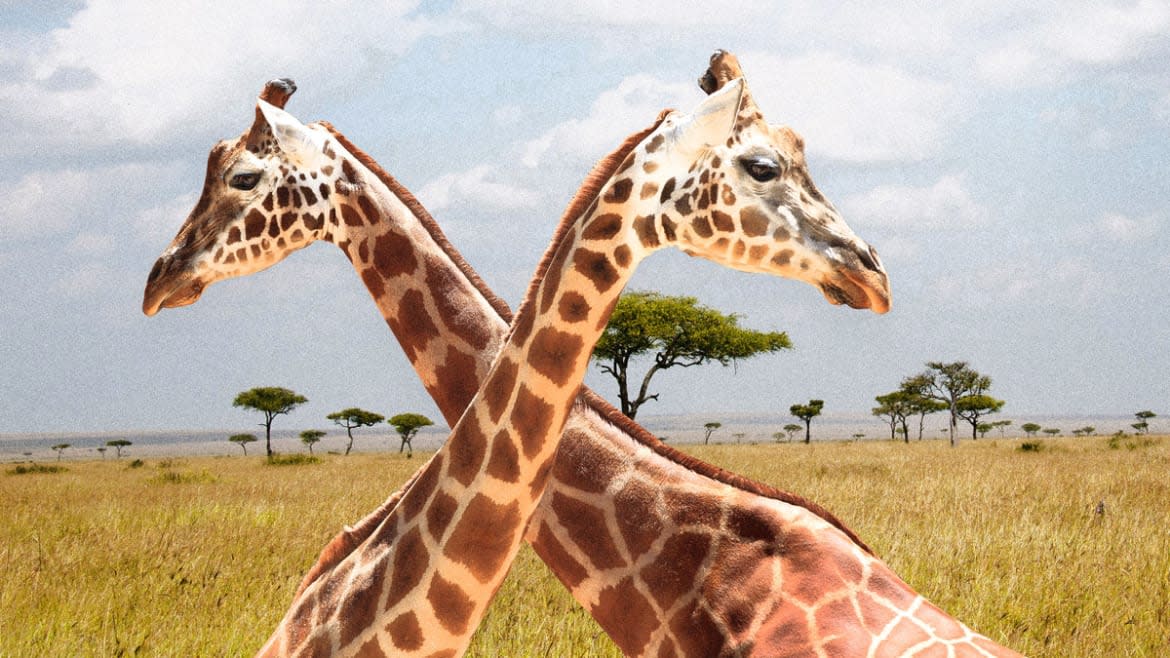Turns Out Giraffes Evolved Long Necks for Combat and Sex

The origin behind giraffes’ long necks has long fascinated scientists. For more than a century, the going theory was that it was due to evolutionary pressure to reach leaves and other foliage to eat. However, it turns out, it might be due to a more X-rated reason: sex.
In a paper published Thursday in the journal Science, researchers in China have discovered fossils of a new giraffe species dating back 17 million years ago. These fossils show a short-necked animal, dubbed Discokeryx xiezhi, with a thick-boned skull and complicated head-neck joints adapted for headbutting. The new finding lends credence to the idea that “necking”—male giraffes clubbing each other with their necks and shoulders in ritual combat while fighting over mates—may be the main or at least contributing force behind the giraffe’s long-necked evolution.
This Tiny Robotic Crab Is the World’s Smallest Remote-Controlled Walking Robot
A large part of why the “necks for food” evolutionary theory has prevailed is in no small part to Charles Darwin. The English naturalist was the first to propose that the spotty giraffe developed its nearly 600-pound neck through successive generations reaching for foliage just out of reach. For many years, this theory was accepted and the giraffe’s neck became a textbook case for natural selection. But in 1996, zoologists Robert Simmons and Lue Scheepers proposed that the “necking” competitions between males favored the evolution of ever-longer necks through sexual selection, where impressed females mated with the long-necked champions, reported National Geographic in 2013.
But living giraffes can’t tell us everything about how they evolved, which is where fossils come in. In the new Science paper, the researchers discovered that D. xiezhi had thick helmet-like skulls that were quite plastic and flexible. The creatures also had enlarged neck joints that would have given early giraffes the ability to headbutt each other at high speeds.
“The peculiar head-neck morphology was most probably adapted for a fierce intermale headbutting behavior, comparable to neck-blowing in male giraffes but indicative of an extreme adaptation in a different direction within giraffoids,” the authors wrote in their paper.
The Pet Spider Black Market Is a Sprawling and Dangerous Web
The researchers also noticed D. xiezhi’s tooth enamel had the second-highest average of carbon-13, a radioactive form of carbon used for dating, compared to all herbivores existing alongside it. Carbon-13 can provide evidence of the ecology and habitat of a long-dead animal and these findings seem to suggest our modern giraffe’s early ancestor was likely an open-land grazer residing in areas uninhabited by other herbivores. The researchers hypothesize that because D. xiezhi didn’t have any competition when it came to food, “necking” and the inevitable mating with the strongest, long-necked champion alone might have driven the giraffe’s evolution.
These new fossil records paint a better picture of what early giraffes roaming the ancient world looked like and how their behaviors and environment may have shaped their modern physiology. While it’s still yet to be seen whether these fossils outright dismiss the “necks for food” evolutionary theory, it definitely makes you consider these magnificent, gentle-seeming animals in a pugilistic new light.
Got a tip? Send it to The Daily Beast here
Get the Daily Beast's biggest scoops and scandals delivered right to your inbox. Sign up now.
Stay informed and gain unlimited access to the Daily Beast's unmatched reporting. Subscribe now.

